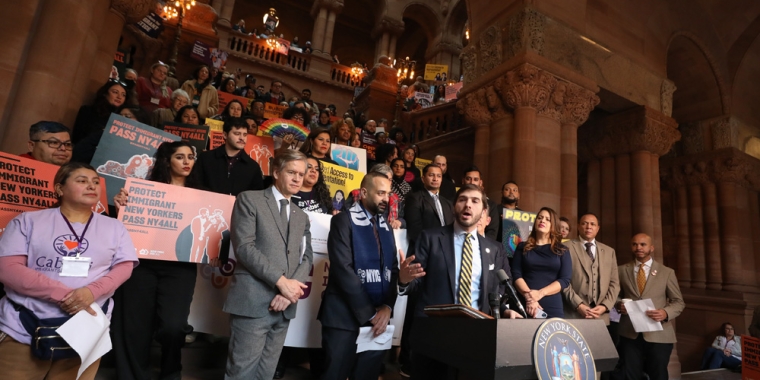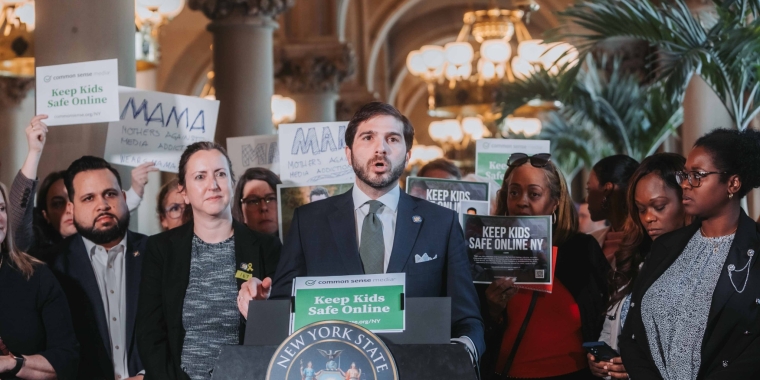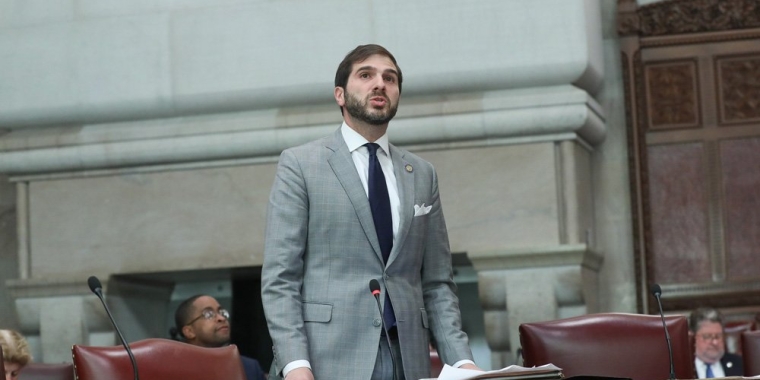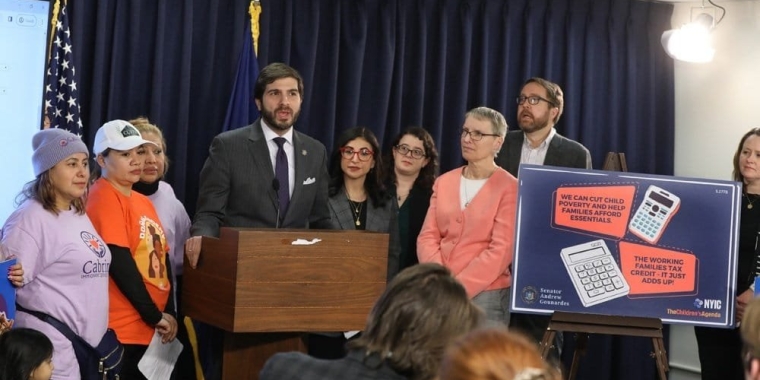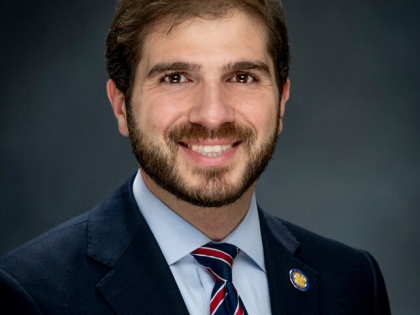
House passes spending bill with 2-way Verrazzano Bridge tolls
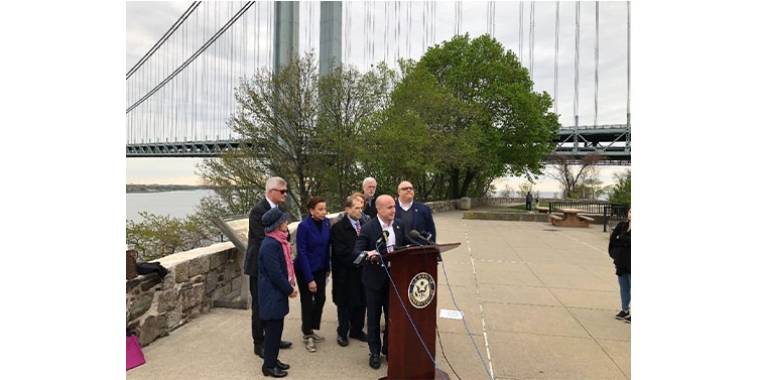
U.S. Reps. Max Rose (at podium), Jerrold Nadler and Nydia Velázquez were joined by colleagues and MTA officials at a press conference focusing on bridge tolls earlier this year. Photo courtesy of Rose’s office
Two-way tolls on the Verrazzano-Narrows Bridge are on the verge of becoming a reality now that the House of Representatives has passed a massive appropriations bill.
U.S. Reps. Max Rose, Jerrold Nadler and Nydia Velázquez worked to eliminate language from a spending bill that would have kept the current one-way toll system in place. The toll is collected from drivers traveling toward Staten Island. Brooklyn-bound motorists cross the bridge for free.
The appropriations bill, passed by the House on Tuesday, will now go to the U.S. Senate for a vote.
Rose, a Democrat who represents Southwest Brooklyn and Staten Island, spoke on the House floor prior to the vote.
“Split tolling cuts the toll in half and collects it in both directions, closing the loophole at no cost to commuters in Brooklyn or on Staten Island,” Rose said.
Rose, Nadler and Velázquez had argued that under the one-way toll system, which was put in place through federal legislation more than two decades ago, drivers heading east avoid paying a toll and then avoid the toll again on the return trip, bypassing the Verrazzano in favor of other routes.
“For far too long, one-way tolling on the Verrazzano bridge has meant more commercial traffic making its way across Staten Island and then through Brooklyn communities and Chinatown as trucks try to dodge tolls,” Velázquez said last month after the House Appropriations Committee passed the spending bill. Velázquez is a Democrat whose district includes parts of Brooklyn, Manhattan and Queens.
Enacting a two-way toll could bring $10 million to $15 million in additional revenue to the MTA, according to Rose, who added that the extra money could be used to fix transit service in his Brooklyn-Staten Island district.
U.S. Reps. Max Rose (at podium), Jerrold Nadler and Nydia Velázquez were joined by colleagues and MTA officials at a press conference focusing on bridge tolls earlier this year. Photo courtesy of Rose’s office
Two-way tolls on the Verrazzano-Narrows Bridge are on the verge of becoming a reality now that the House of Representatives has passed a massive appropriations bill.
U.S. Reps. Max Rose, Jerrold Nadler and Nydia Velázquez worked to eliminate language from a spending bill that would have kept the current one-way toll system in place. The toll is collected from drivers traveling toward Staten Island. Brooklyn-bound motorists cross the bridge for free.
The appropriations bill, passed by the House on Tuesday, will now go to the U.S. Senate for a vote.
Rose, a Democrat who represents Southwest Brooklyn and Staten Island, spoke on the House floor prior to the vote.
“Split tolling cuts the toll in half and collects it in both directions, closing the loophole at no cost to commuters in Brooklyn or on Staten Island,” Rose said.
Rose, Nadler and Velázquez had argued that under the one-way toll system, which was put in place through federal legislation more than two decades ago, drivers heading east avoid paying a toll and then avoid the toll again on the return trip, bypassing the Verrazzano in favor of other routes.
“For far too long, one-way tolling on the Verrazzano bridge has meant more commercial traffic making its way across Staten Island and then through Brooklyn communities and Chinatown as trucks try to dodge tolls,” Velázquez said last month after the House Appropriations Committee passed the spending bill. Velázquez is a Democrat whose district includes parts of Brooklyn, Manhattan and Queens.
Enacting a two-way toll could bring $10 million to $15 million in additional revenue to the MTA, according to Rose, who added that the extra money could be used to fix transit service in his Brooklyn-Staten Island district.
“Cutting down on out-of-state toll shopping will also generate revenues for New York to invest in mass transit projects on Staten Island and in South Brooklyn — two places that all levels of government have consistently ignored or ripped off for a generation now. Finally, my constituents are starting to see a new day after a long commuting nightmare — fewer cars on our streets, better buses, more mass transit options, and credible alternatives to reach the other boroughs,” Rose said.
The return of two-way tolls would also lead to health benefits, said Nadler, a Democrat whose district includes parts of Brooklyn and Manhattan. “The restoration of two-way tolling will significantly reduce traffic congestion while improving road traffic safety and air quality across New York,” Nadler said
State Sen. Andrew Gounardes, who sponsored a bill in the state legislature that would have reduced the $19 toll for Brooklyn residents who drive over the bridge 10 times or more a month, said he supports two-way tolls but wants to see the MTA act in an equitable manner when it comes to transit repairs.
“For the Brooklyn residents who rely on the Verrazzano … the $19 toll is highway robbery. While I’m supportive of two-way tolling, my main concern is ensuring that we fund our broken transit system equitably and fairly, without fleecing southern Brooklynites,” Gounardes told the Brooklyn Eagle.
Another state lawmaker, Assemblymember Nicole Malliotakis, a Republican representing parts of Bay Ridge and Staten Island, said she’s not opposed to two-way tolls but is demanding that the MTA to release the results of a study conducted to determine the impact two-way tolls would have on Brooklyn and Staten Island.
Malliotakis said she wrote to MTA Chairperson Patrick Foye on May 20 and filed a Freedom of Information request on June 13.
“Residents are skeptical and rightfully so, considering the MTA has been silent as to how this would impact traffic on the Staten Island Expressway [and] the southbound Gowanus during evening rush and regional tolling,” Malliotakis said. “I am not closed to the idea of two-way tolling, but I need to be shown that this is not just another Ponzi scheme by the MTA.”
MTA officials did not respond to requests for comment.
